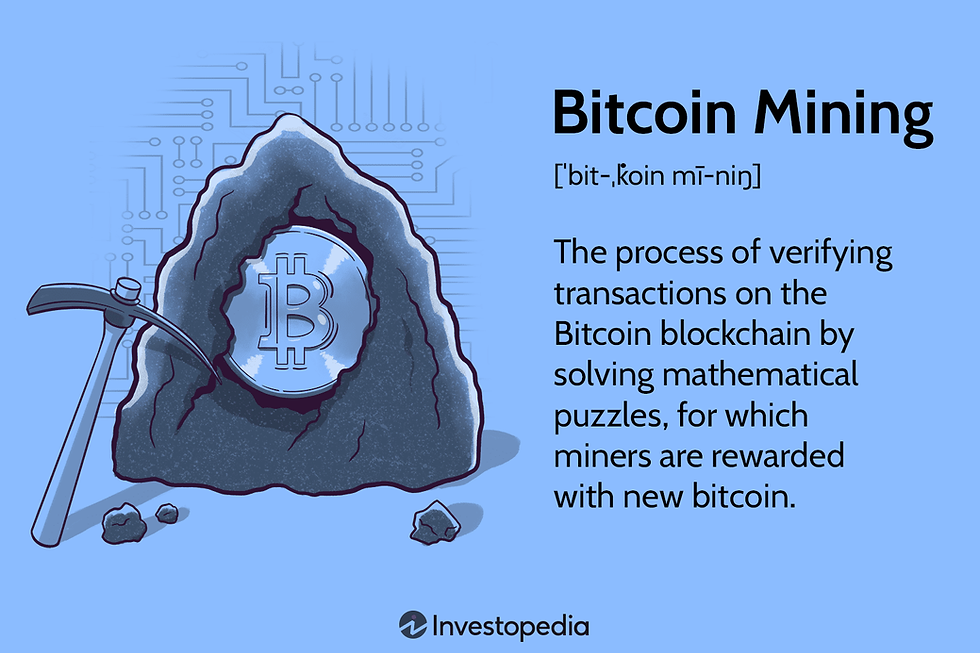What Is Bitcoin Mining?
- Slava Jefremov
- Aug 18
- 4 min read

Introduction
Bitcoin mining is the foundation of the Bitcoin ecosystem. It not only secures the blockchain but also ensures that new coins enter circulation in a transparent and decentralized manner.
By solving complex mathematical problems with powerful hardware, miners validate transactions, prevent fraud, and maintain the integrity of the network. For those new to cryptocurrency, learning about mining provides key insights into how Bitcoin operates and why it continues to be trusted globally. This guide explores the history of mining hardware, the basics of starting out, the financial realities of mining, and how platforms like ViaBTC simplify the process for beginners.
The Evolution of Mining Hardware: From CPU to GPU to ASIC
When Bitcoin was first introduced in 2009, anyone with a standard computer could mine coins using a CPU (central processing unit). At the time, mining difficulty was extremely low, and CPUs could easily solve cryptographic puzzles while consuming relatively little power. However, as more participants joined the network, competition increased, making CPU mining inefficient.
To meet this rising challenge, miners shifted to GPUs (graphics processing units). GPUs could perform many more parallel calculations than CPUs, enabling much faster hashing power and higher efficiency. This era also saw the rise of mining pools, where groups of miners combined computational resources to stabilize earnings and reduce variance in rewards.

By 2013, the landscape changed again with the arrival of ASICs (application-specific integrated circuits). Unlike general-purpose CPUs and GPUs, ASICs are tailor-made for Bitcoin’s SHA-256 proof-of-work algorithm. These specialized machines deliver vastly superior hash rates and consume less electricity per unit of work, rendering previous hardware types obsolete. Since then, ASICs have dominated the industry, with ongoing design improvements fueling a competitive “arms race” among manufacturers.
This progression clearly shows how Bitcoin mining evolved from casual, home-based activity into an industrial-scale operation where efficiency, cost control, and cutting-edge hardware determine long-term profitability.
How Mining Works, Entry Costs, and Expected Returns
At its core, Bitcoin mining operates through the proof-of-work consensus system. Miners compete to solve a cryptographic puzzle by adjusting nonce values until they generate a hash below the network’s target difficulty. Once a valid solution is found, the block is broadcast to the network, verified by other nodes, and permanently added to the blockchain. The miner responsible receives rewards in the form of newly minted Bitcoins plus transaction fees.
For beginners, entering the mining space requires significant upfront investment. ASIC miners—now the standard hardware—can cost anywhere from several thousand dollars to well over $10,000 depending on their hash rate, energy efficiency, and brand. Alongside the hardware, miners must also invest in stable electricity, reliable internet connectivity, cooling systems, and monitoring tools. Energy usage is a major factor, as mining consumes considerable electricity, making power costs a key component of profitability.
Returns on mining vary greatly. Profitability depends on multiple factors including Bitcoin’s market price, mining difficulty (which automatically adjusts every two weeks), local electricity rates, and the efficiency of the chosen hardware. In regions with low-cost electricity, miners may recover their investment more quickly, while others face slimmer margins. Because solo mining is rarely profitable for beginners due to high difficulty, most newcomers join mining pools like ViaBTC. These pools allow participants to combine computational power, providing more consistent and predictable payouts proportionate to each miner’s contribution.
How ViaBTC Helps Beginners Get Started Quickly
ViaBTC has established itself as a comprehensive, beginner-friendly mining platform, offering tools and services that lower entry barriers for new miners and streamline the mining experience:
Tutorial Videos and Help Center: ViaBTC provides detailed, step-by-step tutorials on hardware setup, mining software, pool configuration, and profit tracking. Their Help Center is packed with answers to common questions, ensuring newcomers can resolve challenges quickly.
Community Support: Through active Telegram groups, Twitter channels, and other social platforms, ViaBTC connects miners with experts and peers, fostering knowledge-sharing and timely troubleshooting.
Mining Pool Services: ViaBTC pools distribute rewards on an hourly basis, giving miners frequent, predictable payouts. A real-time monitoring dashboard lets users track machine health, hash rates, and earnings with ease.
Mining Tools and Resources: The ViaBTC blog and official website host profitability calculators, hardware reviews, and educational guides. These resources help miners evaluate costs, forecast returns, and make smarter decisions about equipment and operations.
By combining these tools with reliable support, ViaBTC enables beginners to enter the mining industry with confidence and avoid many of the technical hurdles that once discouraged newcomers.
Conclusion
Bitcoin mining is far more than just a technical process—it is the backbone of the Bitcoin network. By validating transactions and securing the blockchain, miners ensure Bitcoin remains decentralized, transparent, and resilient. Over the years, mining has evolved from CPU-based hobbyist experiments to today’s industrial-scale ASIC-driven operations, where efficiency and costs dictate success.
For beginners, the financial investment, electricity demands, and profitability challenges may seem daunting, but platforms like ViaBTC provide invaluable support, tools, and community guidance. Whether you are exploring mining as a learning experience or a potential investment, understanding its mechanics and leveraging beginner-friendly ecosystems can help you start your journey with greater confidence.
FAQs
What are the basic principles behind Bitcoin mining?
Mining involves solving cryptographic puzzles using proof-of-work. Miners repeatedly hash block data with different nonces until one generates a valid hash under the difficulty target. The winning miner adds the block to the blockchain and earns rewards, helping to secure the network.
Is Bitcoin mining profitable?
Profitability depends on hardware efficiency, energy prices, Bitcoin’s market value, and overall network difficulty. While some operations in regions with cheap electricity can achieve strong returns, others face narrow margins. Careful cost analysis and ongoing evaluation are critical before investing.
Where can I find beginner-friendly mining resources?
ViaBTC provides beginner-focused resources including tutorial videos, a comprehensive Help Center, active community channels, real-time pool monitoring, profitability calculators, and an educational blog designed to simplify the learning curve.



Comments